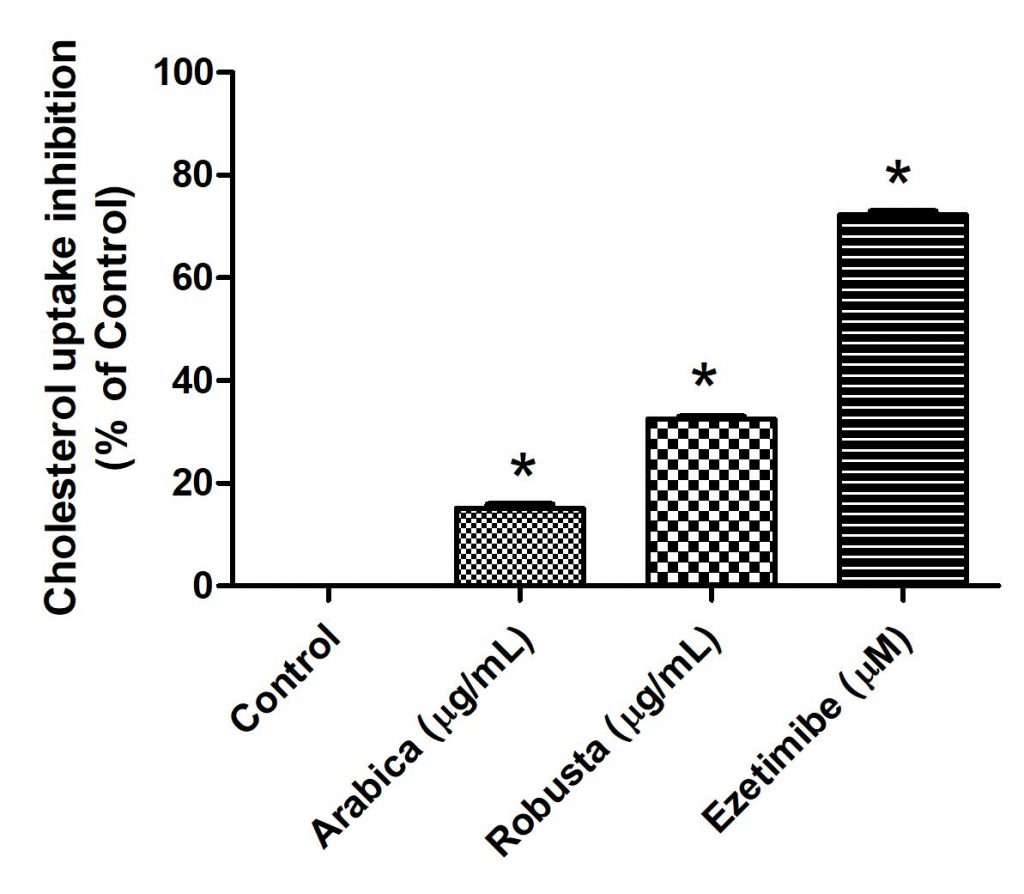

Highlight
การวิเคราะห์พบว่าใบกาแฟ Robusta มีกรดคลอโรจีนิกสูง (18.15 มก./กรัม) แต่ใบกาแฟ Arabica มีคาเฟอีนสูง (19.82 มก./กรัม) ใบกาแฟทั้งสองชนิดยังแสดงผลการยับยั้งเอนไซม์ไลเปสและการดูดซึมคอเลสเตอรอลได้ดี โดยใบกาแฟ Arabica มีประสิทธิภาพในการยับยั้งเอนไซม์ไลเปสสูงกว่า ขณะที่ใบกาแฟ Robusta มีในการลดการดูดซึมคอเลสเตอรอลสูงกว่า
ที่มาและความสำคัญ
ใบและเนื้อผลกาแฟมีสารออกฤทธิ์ทางชีวภาพหลายชนิด เช่น อัลคาลอยด์ (caffeine, trigonelline), ฟลาโวนอยด์ (quercetin, rutin), terpenoids (cafestol, kahweol), กรดอะมิโน, ซูโครส, แทนนิน, แซนโทน, กรดฟีนอลิก และคาเทชิน สารสกัดจากใบหรือเนื้อผลกาแฟช่วยลดระดับน้ำตาลในเลือด, คอเลสเตอรอล, ไตรกลีเซอไรด์ และ LDL, และเพิ่ม HDL รวมถึงลดการเกิด lipid peroxidation ในร่างกาย ข้อมูลเหล่านี้แสดงถึงศักยภาพของการนำใบหรือเนื้อผลกาแฟไปศึกษาต่อยอดในกระบวนการย่อยและดูดซึมในทางเดินอาหาร และพัฒนาผลิตภัณฑ์เพื่อสุขภาพในอนาคต ในการศึกษานี้จึงสนใจที่จะศึกษาความคงตัวต่อกระบวนการย่อย และการขนส่งผ่านเซลล์ลำไส้เพาะเลี้ยง Caco-2 และความปลอดภัยของสารสกัดใบกาแฟในเซลล์ลำไส้เพาะเลี้ยง Caco-2
Abstract
Background: Coffee leaves are a major source of bioactive components and are used as ethnomedicine. However, despite their traditional medicinal use, information about their effects on antihyperlipidemia remains limited. Methods: The aims of this study were to evaluate the main components of leaf extracts from Arabica and Robusta coffees and to examine the potential of these coffee leaves in reducing lipid digestion and absorption in vitro. Results: Coffee leaf extracts from Arabica coffee contain a high amount of caffeine, whereas extracts from Robusta coffee contain high amounts of chlorogenic acid (CGA) and caffeine. Additionally, leaf extracts from Arabica and Robusta coffee demonstrated the inhibition of pancreatic lipase, decreased micellar cholesterol solubility, and reduced bile acid binding. Furthermore, these extracts resulted in a reduction in cholesterol uptake in Caco-2 cells. Molecular docking experiments supported this discovery, showing CGA and caffeine binding to Niemann–Pick C1-like 1 (NPC1L1), a key protein in cholesterol absorption. The results indicated that CGA and caffeine can competitively bind to NPC1L1 at the cholesterol binding pocket, reducing its cholesterol binding rate. These findings suggest that coffee leaves might help suppress lipid absorption and digestion, highlighting their potential use in preventing and treating hyperlipidemia.
KEYWORDS: coffee leaves, pancreatic lipase, cholesterol micelles, bile acid binding, lipid absorption
Citation: Sansri, V.; Sroyraya, M.; Phisalprapa, P.; Yosboonruang, A.; Ontawong, A.; Saokaew, S.; Goh, B.-H.; Trisat, K.; Phewchan, P.; Rawangkan, A.; et al. Suppressive Effect of Coffee Leaves on Lipid Digestion and Absorption In Vitro. Foods2024, 13, 2445. https://doi.org/10.3390/foods13152445
RELATED SDGs:
SDG Goal หลัก ที่เกี่ยวข้อง
3. GOOD HEALTH AND WELL-BEING

SDG Goal ที่เกี่ยวข้องอื่น ๆ
2. ZERO HUNGER

ผู้ให้ข้อมูล: ผู้ช่วยศาสตราจารย์ ดร.มรกต สร้อยระย้า
ชื่ออาจารย์ที่ทำวิจัย: ผู้ช่วยศาสตราจารย์ ดร.มรกต สร้อยระย้า
Credit ภาพ: ผู้ช่วยศาสตราจารย์ ดร.มรกต สร้อยระย้า
Tags: bile acid binding, cholesterol micelles, coffee leaves, lipid absorption, pancreatic lipase
